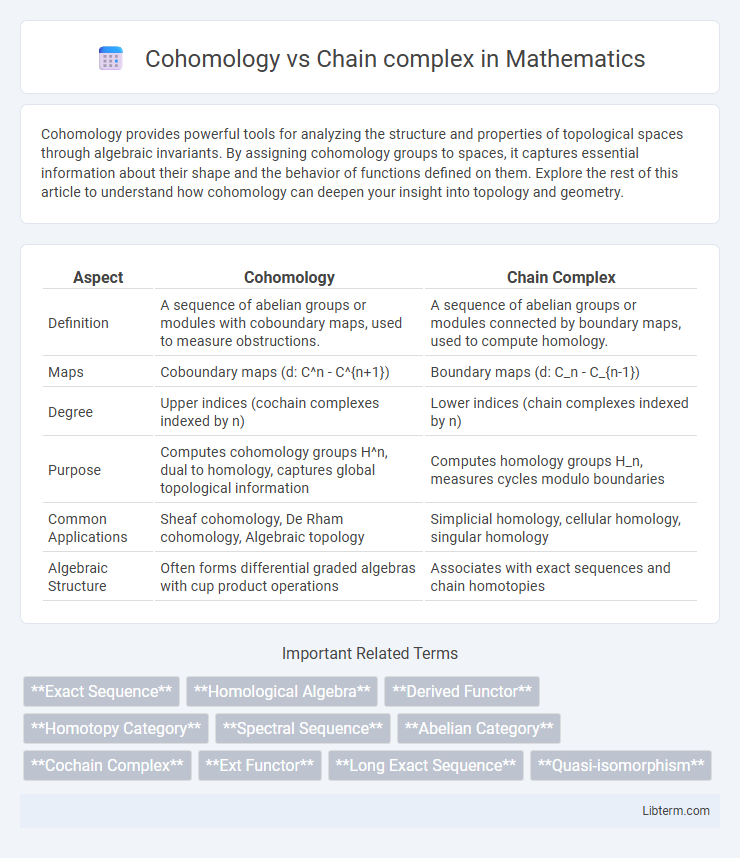Cohomology provides powerful tools for analyzing the structure and properties of topological spaces through algebraic invariants. By assigning cohomology groups to spaces, it captures essential information about their shape and the behavior of functions defined on them. Explore the rest of this article to understand how cohomology can deepen your insight into topology and geometry.
Table of Comparison
| Aspect | Cohomology | Chain Complex |
|---|---|---|
| Definition | A sequence of abelian groups or modules with coboundary maps, used to measure obstructions. | A sequence of abelian groups or modules connected by boundary maps, used to compute homology. |
| Maps | Coboundary maps (d: C^n - C^{n+1}) | Boundary maps (d: C_n - C_{n-1}) |
| Degree | Upper indices (cochain complexes indexed by n) | Lower indices (chain complexes indexed by n) |
| Purpose | Computes cohomology groups H^n, dual to homology, captures global topological information | Computes homology groups H_n, measures cycles modulo boundaries |
| Common Applications | Sheaf cohomology, De Rham cohomology, Algebraic topology | Simplicial homology, cellular homology, singular homology |
| Algebraic Structure | Often forms differential graded algebras with cup product operations | Associates with exact sequences and chain homotopies |
Introduction to Cohomology and Chain Complexes
Cohomology is a mathematical framework that assigns algebraic invariants to topological spaces, capturing their structural properties through a sequence of abelian groups or modules. Chain complexes consist of sequences of abelian groups or modules connected by boundary operators, whose compositions are zero, serving as the foundation for defining homology and cohomology groups. Understanding chain complexes is essential for constructing cohomology theories, where cochains are defined as homomorphisms on chains, revealing deeper geometric and topological insights.
Defining Chain Complexes: Basic Concepts
Chain complexes consist of a sequence of abelian groups or modules connected by boundary maps whose compositions are zero, ensuring exactness at each stage. Cohomology arises from chain complexes by defining cochain complexes with coboundary operators, measuring the failure of exactness and capturing topological or algebraic invariants. Understanding the structure of chain complexes and their differential maps is fundamental for computing cohomology groups in algebraic topology and homological algebra.
Understanding Cohomology: Key Ideas
Cohomology captures algebraic invariants arising from chain complexes by associating cochain groups and differential maps that reflect topological or algebraic structure. It measures the failure of exactness in a cochain complex, with cohomology groups defined as the quotient of closed cochains modulo exact cochains, indicating obstructions and global properties. Understanding cohomology involves recognizing these groups as tools for classifying features like holes, extensions, or deformations in spaces or algebraic objects.
The Relationship Between Cohomology and Chain Complexes
Cohomology arises naturally from chain complexes by applying a cochain functor that reverses the arrows and produces cochain complexes whose cocycles and coboundaries define cohomology groups. These cohomology groups measure the failure of exactness in the chain complexes and provide algebraic invariants that classify topological spaces or algebraic structures. The structure of a chain complex enables computation of cohomology, revealing information about holes and obstructions in underlying spaces.
Algebraic Structures in Chain Complexes
Chain complexes consist of sequences of abelian groups or modules connected by boundary operators whose composition is zero, forming the algebraic framework for homological algebra. Algebraic structures in chain complexes enable the computation of homology groups, capturing topological and algebraic invariants through cycles and boundaries. Cohomology, derived from these chain complexes via dualization or cochain complexes, enriches this framework by incorporating ring and module structures, facilitating deeper algebraic and geometric interpretations.
Cohomology Groups: Construction and Interpretation
Cohomology groups are constructed by applying the hom functor to a chain complex, resulting in a cochain complex where coboundary operators define cocycles and coboundaries. These groups measure the failure of exactness in the cochain complex, capturing topological and algebraic invariants such as H^n(X; G) in algebraic topology. Cohomology groups provide dual information to homology groups, enabling classification of spaces through characteristic classes and extension problems in algebraic geometry and homological algebra.
Exact Sequences in Chain Complexes and Cohomology
Exact sequences in chain complexes provide a fundamental tool for relating homology groups, enabling the decomposition of complex algebraic structures into simpler components. In cohomology, exact sequences reveal the underlying algebraic invariants by tracking the kernel and image of coboundary maps within cochain complexes. These sequences facilitate computations in algebraic topology and homological algebra by connecting chain complexes, cochain complexes, and their homology or cohomology groups through long exact sequences.
Applications of Cohomology in Mathematics
Cohomology provides powerful tools in algebraic topology, enabling the classification of topological spaces through invariants such as Betti numbers and characteristic classes. It plays a crucial role in algebraic geometry by linking geometric properties with algebraic structures, particularly via sheaf cohomology and the study of divisors. Applications extend to number theory and differential geometry, where cohomology groups facilitate the analysis of solutions to differential equations and the behavior of manifolds.
Computational Techniques for Cohomology and Chain Complexes
Computational techniques for cohomology and chain complexes leverage algorithms like Smith normal form and persistent homology to efficiently compute homology and cohomology groups from boundary matrices and chain maps. Matrix reduction methods optimize the processing of chain complexes, enabling scalable calculations in topological data analysis and algebraic topology. Software tools such as CHomP, Dionysus, and GUDHI implement these techniques, facilitating practical applications in computational geometry and data science.
Key Differences and Similarities: Cohomology vs Chain Complex
Cohomology and chain complexes are fundamental concepts in algebraic topology with chain complexes consisting of sequences of abelian groups connected by boundary operators, used to compute homology. Cohomology arises from the dual notion, involving cochain complexes and coboundary operators, providing invariants that classify topological spaces up to homotopy equivalence. Both structures encode topological information, but cohomology groups often carry additional algebraic structures, such as cup products, enabling richer analysis than the purely additive structure in chain complexes.
Cohomology Infographic

 libterm.com
libterm.com